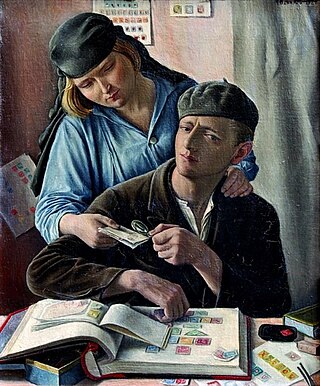
Stamp collecting is the collecting of postage stamps and related objects. It is an area of philately, which is the study of stamps. It has been one of the world's most popular hobbies since the late nineteenth century with the rapid growth of the postal service, as a stream of new stamps was produced by countries that sought to advertise their distinctiveness through their stamps.
The American Philatelic Society (APS) is the largest nonprofit stamp collecting foundation of philately in the world. Both the membership and interests of the society are worldwide.
Alfred F. Lichtenstein was one of the most famous American philatelists.
The Collectors Club, often referred to as the Collectors Club of New York, is a private club and philatelic society in New York City. Founded in 1896, it is one of the oldest existing philatelic societies in the United States. Its stated purpose is "to further the study of philately, promote the hobby and provide a social, educational, and non-commercial setting for the enthusiastic enjoyment of our common passion".

Walter Morley (1863–1936) was a pioneering English philatelist, stamp dealer and philatelic author.

August Dietz was a philatelist, editor and publisher, who specialized in the study of mail and postal history of the Confederate States of America.

Theodore Edwin Steinway, of the Steinway piano family, was a member of the Collectors Club of New York and board of trustees of the Philatelic Foundation. He was awarded the first Lichtenstein Medal in 1952 for his efforts in the field of philately as well as his contributions to the growth and prestige of the Collectors Club.
Beverly Sedgwick King, of New York City, was an American architect, a partner with Henry D. Whitfield in the firm Whitfield & King. He is now known primarily for his work as a philatelist who specialized in the collecting of, and writing philatelic literature on, United States postage stamps.
John Robert Boker Jr. was an American philatelist who amassed some of the most prestigious collections of 19th century stamps ever seen by stamp collectors. Before his death in 2003, the Collectors Club of New York declared him, in 1996, to be the "outstanding philatelist of the last half of the twentieth century."

John Walter Scott of New York City, was originally from England, but he emigrated to the United States to take part in the California Gold Rush. Unsuccessful at the prospecting trade, Scott began to sell postage stamps for collectors and in a short period of time became the nation's leading stamp dealer. During his lifetime, he was known as "The Father of American Philately" by his fellow stamp collectors.

The Roll of Distinguished Philatelists (RDP) is a philatelic award of international scale, created by the Philatelic Congress of Great Britain in 1921. The Roll consists of five pieces of parchment to which the signatories add their names.

Edward Haven Mason, of Boston, Massachusetts, was the first philatelist to study, and to write on, proofs and essays of United States postage stamps and postal stationery.
Sidney F. Barrett (1892–1958) of New York City, was a prominent stamp dealer who participated in various important philatelic ventures in New York City itself.
Charles James Phillips of London, England, and New York City, was a philatelist highly regarded in both England where he started his philatelic career and in the United States, where he emigrated to in 1922.

William Penn Brown (1841–1929), of New York City, was an early pioneer in the hobby of stamp collecting. Brown was born in India of missionary parents and was raised in Japan before he came to the United States and started a successful business selling stamps in New York City in 1860.
Nancy B. Clark was an American philatelist who served the philatelic community by her pioneering work with the Boy Scouts of America and her dedication to work at the American Philatelic Society. Clark died on January 29, 2024, at the age of 77.
Morton Dean Joyce (1900–1989), of New York City, was a philatelist who specialized in the collection of United States revenue stamps and became known by his philatelic friends as the "Dean of United States revenue collectors."

The origins of the Collectors Club of Chicago (CCC) are traced to the informal meetings during the 1920s of specialized collectors residing in the Chicago area.

William Thorne was a wealthy American businessman and philatelist. In poor health, he retired early from the leather trade and began to collect postage stamps. He was one of the founders of the Philatelic Society of New York and the second president of the Collectors Club of New York. He was the owner of the unique block of four of the 1869 24¢ United States stamps with inverted center. He sold his collection but restarted in order to provide a distraction from his poor health. He died in 1907 after three operations for what was thought to be throat cancer.










